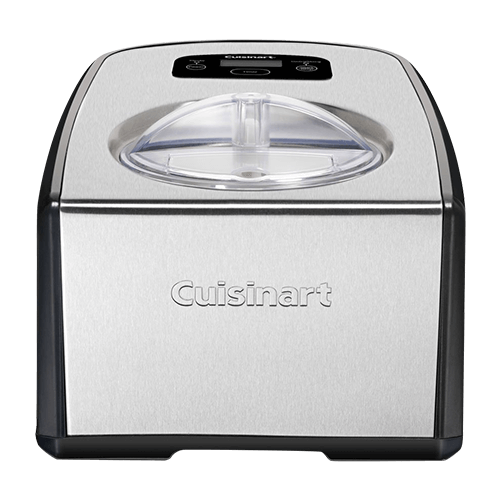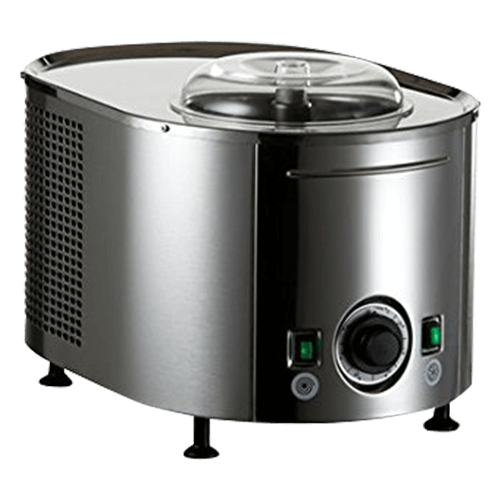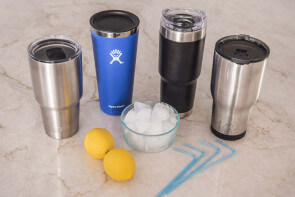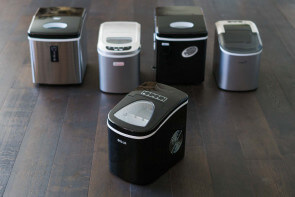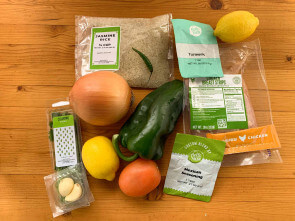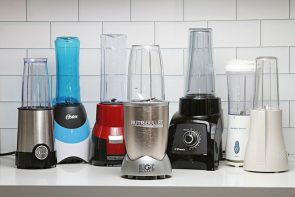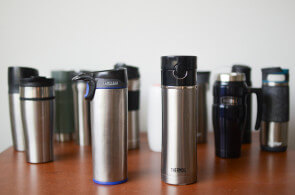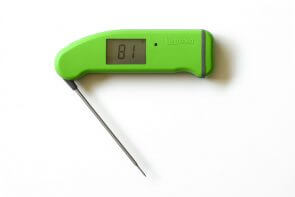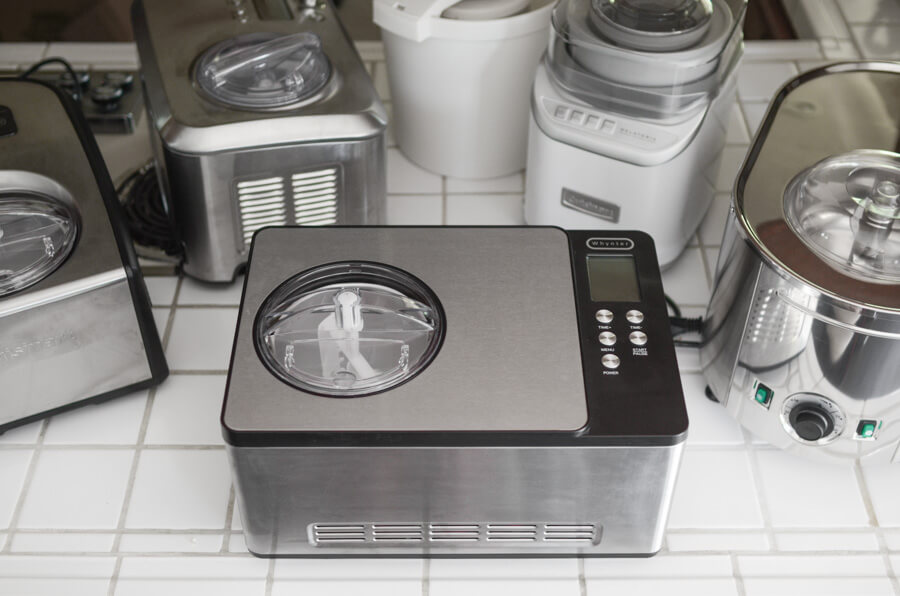
The Best Ice Cream Makers
After making dozens of ice cream and sorbet pints in our quest to find the best ice cream maker and testing six highly rated machines, we decided that the Whynter – ICM-200LS Ice Cream Maker is the champion in churning out the rich and creamy treats you’d expect from a top-quality ice cream shop. Our runner-up choice is the Cuisinart – ICE-100 Ice Cream and Gelato Maker.
After making dozens of ice cream and sorbet pints in our quest to find the best ice cream maker and testing six highly rated machines, we decided that the Whynter – ICM-200LS Ice Cream Maker is the champion in churning out the rich and creamy treats you’d expect from a top-quality ice cream shop. Our runner-up choice is the Cuisinart – ICE-100 Ice Cream and Gelato Maker.
Table of contents
- The 6 ice cream makers we tested
- 1. Best overall: Whynter – ICM-200LS
- 2. The runner-up: Cuisinart – ICE-100
- 3. Best for enthusiasts: Musso – 4080
- Other products we tested
- How we selected
- How we tested
- Expert advice for making ice cream
- Important features to consider
- The bottom line
The 6 ice cream makers we tested

| Product | Price | Type | Ease of Use | Churn Time (per quart) |
|---|---|---|---|---|
| 1. Whynter - ICM 200-LS | $$$ | Compressor | 5/5 | 25 minutes |
| 2. Cuisinart - ICE-100 | $$$ | Compressor | 5/5 | 34 minutes |
| 3. Lello - 4080 Musso Lussino | $$$$ | Compressor | 4/5 | 40 minutes |
| 4. Breville - Smart Scoop | $$$ | Compressor | 4/5 | 28 minutes |
| 5. Cuisinart - ICE-60 | $$ | Freezer bowl | 3/5 | 20 minutes |
| 6. Hamilton Beach - 68330N | $ | Ice and rock salt | 1/5 | 50 minutes |

1. Best overall: Whynter – ICM-200LS
The compressor models were certainly more convenient and easy to operate than the freezer bowl and automatic ice-and-salt models. Overall the compressor models performed reasonably as well as advertised.
However, we found that the Whynter – ICM-200LS stood out as the best compressor model that churned out extremely smooth, creamy and dense ice cream you’d expect from a high-end, artisan ice-cream parlor. Whynter is known for refrigeration and air conditioning and their expertise was clearly applied when they designed an ice cream machine.
The Whynter is incredibly user friendly: You simply pour the ice cream mixture into the canister, snap on the lid and push the “power” button. An LCD screen lights up with the options for Ice Cream, Cooling and Mixing Only (for add-ins once the ice cream has partially solidified). The digital countdown begins at 60 minutes, and you can add or subtract from that default time.
The Whynter’s powerful internal motor (180 watts) churned 1.5 quarts (its total capacity is 2.1 quarts) of vanilla-custard ice cream to completion in only 25 minutes. It was the only ice cream from all of our test subjects that didn’t need to be frozen before serving. It scooped up hard and dense and was perfectly smooth and creamy. An efficient plastic ice-cream scoop is included.
The egg-less chocolate ice cream wasn’t as dense, but it was just as rich-tasting as the vanilla and intensely chocolate-y. The sorbet and non-dairy coconut took slightly longer to churn (28 minutes) and they were also flavorful and smooth.
The Whynter’s extended cooling function kicks in automatically when the timer hits zero and the unit keeps the ice cream chilled for 30 minutes.
The removable canister and dasher were easy to wash and the machine’s stainless steel wipes down beautifully. At over 25 pounds, the Whynter is one of the heaviest of our test subjects, so it’s definitely a countertop appliance.
The Whynter costs about the same as the other compressor models we tested, so it’s not inexpensive. However, because of the excellent quality of the ice cream it makes, we believe it’s a worthwhile investment.
Key takeaways:
- The Whynter churns out ice cream and other frozen desserts that taste exactly like what you would get from a professional ice cream parlor.
- It’s the only machine we tested that makes hard and soft-serve ice cream.
- The Whynter has an add-in spout and programmed menu choice for pausing the churning for add-ins.
- Its 2.1-quart capacity allows you to make a lot of ice cream in a short period of time.
- The machine’s automatic functions are very user-friendly and make ice-cream-making easy and fun.
2. The runner-up: Cuisinart – ICE-100

For our runner-up, we chose another compressor model, the Cuisinart – ICE-100, which consistently churned out very good ice cream and sorbet in about 30 minutes. It runs about $50 less than the Wynter, and although it’s more expensive than the freezer-bowl and ice-and-salt models, we feel the price is worth it for the ICE-100’s quality and convenience.
We opted for the Whynter as our first choice and the Cuisinart – ICE-100 as our runner-up, because all of the ice cream the machine made was soft-serve and needed to be frozen before serving. After four hours of freezing time, the ICE-100’s ice cream and sorbet had the taste and texture of high-end store-bought frozen desserts.
The ICE-100 is easy to use and after a quick wipe-down of the removable bucket and dasher, you can start making ice cream (as long as you have the mixture ready) with the unit straight out of the box. The ICE-100 has only three functions on its touchpad control: on/off, start/stop and a programmable LCD timer. A second dasher for making gelato is included, but we really didn’t notice much difference in the churning.
Once the ice cream is done, the machine goes into an automatic cooling mode for 10 minutes. Unless you enjoy a soft-serve consistency, we recommend freezing the ICE-100’s ice cream for two hours to let it firm up before serving.
The ICE-100 is about the same size as the Whynter, yet it makes somewhat less ice cream (1.5 quarts) and it doesn’t have a spout for add-ins. The machine’s stainless steel is easy to clean and the unit would make an attractive addition to your kitchen countertop.
While we disagree with Cuisinart’s claim that the ICE-100 is a commercial-quality ice cream maker, it’s certainly a reliable option for the ice-cream aficionado.
Key takeaways:
- The ICE-100 makes very good soft-serve ice cream and gelato with the taste and texture of high-end store-bought ice cream.
- Easy-to-use touchpad controls allow you to pause churning for add-ins.
- Its powerful 150-watt motor efficiently churns 1.5 quarts in 30 minutes or less.
- The ICE-100 has an attractive design and is easy to clean.
3. Best for enthusiasts: Musso – 4080
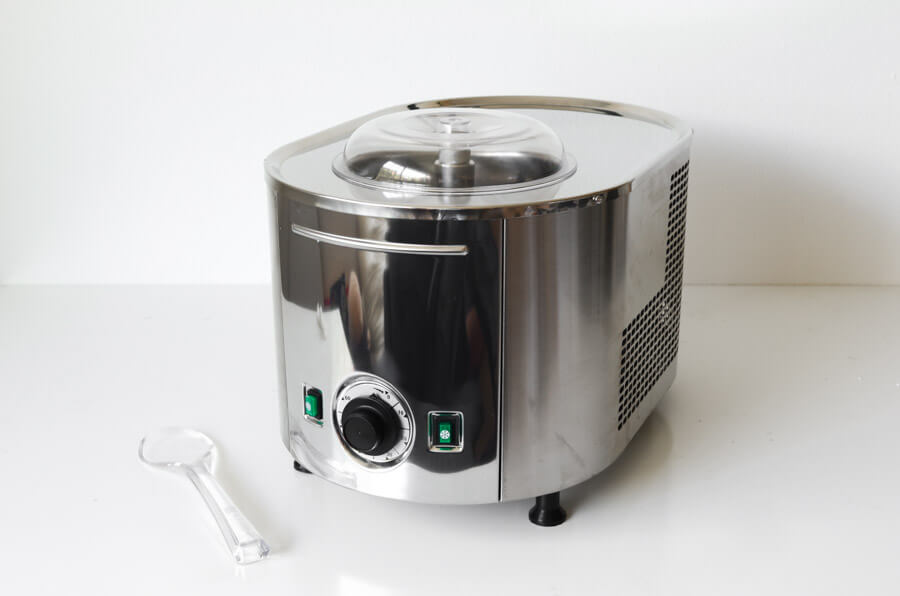
With a price tag of $700, the Musso – 4080 is certainly the Tesla of the ice cream machines we tested. It’s a solidly constructed unit that could easily be used in a restaurant. The Musso’s motor doesn’t have the wattage of the other compressor models we tested, but it’s so efficiently built that it has enough power to whip ice cream into a frothy and airy confection.
The Musso is manufactured in Italy and entirely made of stainless steel, so weighing in at 38 pounds, it’s approximately the size of a small microwave and is clearly intended to have a permanent place in your kitchen. Design-wise, it’s gorgeous, all ovals and sleek curves and when cleaned-up, it gleams. If you ever needed an ice-breaker at a party of strangers, the Musso would be it.
The stainless dasher screws into place and you pour in the ice cream mixture, then set the built-in manual timer (it resembles a vintage kitchen timer) to 40 minutes. The manual suggests 30 minutes, but we found that to be insufficient time. The Musso has two switches: Churn and Chill, and the unit won’t start until the timer is set.
The vanilla-custard ice cream was done in 25 minutes and, of all the ice cream we tasted during our testing, it was the best: super smooth, velvety and flavorful. The eggless chocolate ice cream took five minutes less, and it had the same rich consistency as the vanilla. The sorbet and non-dairy coconut seemed less smooth and flavorful, but once frozen, the magic chemistry happened, and both were luscious.
It should be noted, however, that the ice cream the Musso produced was all soft-serve, which should either be eaten immediately or frozen to firm up.

For all of the beauty of the Musso, we did have a couple of quibbles. The dasher isn’t able to reach the base of the bowl, so we needed to scrape up the quarter-inch thick frozen layer so it could be churned and incorporated into the ice cream.
Second, as noted above, washing the inner bowl and rinsing the soapy water is cumbersome because of the weight of the machine. Consequently, we had to wipe out the bowl several times before we felt confident that all residue was removed.
If you want to make ice cream of professional quality at home and you can afford it, then the Musso is the machine to buy.
Key takeaways:
- Beautifully designed, solidly built and easy to use, the Musso makes professional-quality ice cream at home.
- Its efficient motor and dasher churn out exceedingly smooth, creamy and airy soft-serve ice cream and gelato.
- The Musso is an investment, but if you’re serious about ice cream, it’s worth it.
Other products we tested
4. Breville – BCI600XL Smart Scoop

The highly rated Breville – Smart Scoop comes with lots of bells and whistles and although the ice cream we made in it was acceptable, we didn’t feel the machine merited its considerable price tag.
The Breville is also a compressor unit that chills the machine to -22°F in approximately 10 minutes. It has an impressive LCD panel and various buttons for programming automatic settings for ice cream, gelato, sorbet and frozen yogurt, as well as a knob for adjusting the dessert’s hardness. We found the machine chiming when it’s time for add-ins and when the ice cream is ready to be a useful and accurate feature.
As with most of the other machines, the ice cream had soft-serve consistency and needed to be frozen before serving. We found the texture of the desserts made in the Breville disappointing. The vanilla-custard ice cream was more like frozen whipped cream with a heavy aftertaste of butterfat. The chocolate, sorbet and non-dairy coconut were grainy with ice crystals.
The Breville has a removable bucket and dasher and includes an efficient ice-cream scraper and a small brush for cleaning. The machine has a powerful motor of 200 watts, but it emitted a harsh metallic odor throughout our testing period that never dissipated.
5. Cuisinart – ICE-60W Cool Creations

The Cuisinart – ICE-60W is a freezer-bowl model, so it does require some planning ahead of time because you’ll need to freeze the bowl for at least 12 hours before using it. Since we needed to chill the ice cream mixture for the same amount of time, it really wasn’t an issue for us. Many Amazon reviewers simply store the bowl in their freezers.
The ICE-60W differs most noticeably from the compressor models in that the bucket — not the dasher — revolves. Since the dasher doesn’t move, the ice cream gets stuck in the upper third of the bowl, forming around one of the blades. During the churning, we had to continually scrape the ice cream off the dasher so it could be incorporated into the mixture.
However, despite this bit of maintenance, as we noted earlier, the freezer bowl is very efficient in quickly freezing the ice cream mixture, which began to freeze upon contact with the bowl. All of the ice cream and sorbet made in the ICE-60W were smooth with a soft-serve consistency.
A freezer-bowl model isn’t as convenient as a compressor model, but it’s certainly more affordable. The ICE-60W runs about $100, so it’s a viable option for a less expensive ice cream maker.
6. Hamilton Beach – 68330N 4-Quart
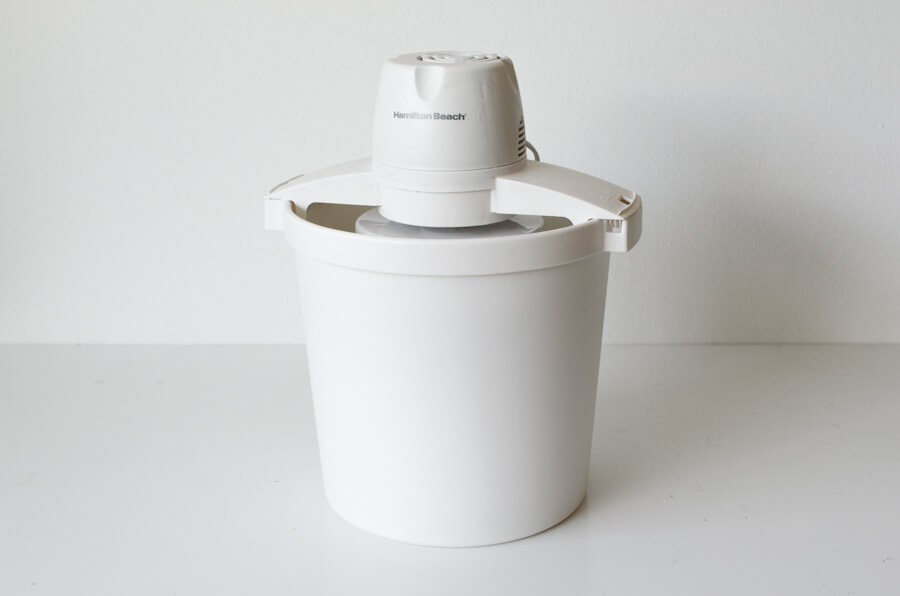
At around $30, the Hamilton Beach – 68330N 4-quart ice cream maker is an Amazon top seller. Reviewers love the nostalgic fun of making ice cream with ice and rock salt and it can make twice as much for larger groups.
However, despite Hamilton Beach’s claim that the model is not labor-intensive, we found it to be just the opposite. It’s a cheaply made product consisting of a plastic bucket, a 4-quart metal cylinder that easily dents, a plastic dasher and a small motor in a plastic casing that snaps on top.
Although it’s motorized, the Hamilton Beach requires 10 pounds of ice and a couple of cups of rock salt, which are layered inside the bucket around the sides of the cylinder. The noisy motor churns the dasher slowly and simply doesn’t have the power to whip enough air into the ice cream.
During the machine’s 50 minutes of churning, we needed to keep an eye on the ice and salt level, adding both half-way through the process. But before doing so, we had to remove the motor and canister, drain out the melted water, re-insert the canister and lock the motor back into place (no small feat).
The Hamilton Beach was definitely not a “set-it-and-forget-it” type of appliance. Whereas the other machines we tested were fun to use, the Hamilton Beach turned ice-cream making into a chore.
How we selected
It’s said that Thomas Jefferson introduced ice cream to the young United States and since then it’s certainly become an American obsession. With hundreds of flavors sold in supermarkets and ice cream parlors, ice cream machines have come a long way since the good ol’ days of churning it by hand with pounds of ice and rock salt.
We began our research by going through articles about the art and science of ice-cream making, including IceCreamScience.com, the American Chemical Society, Cook’s Science, and Serious Eats. We then consulted chefs from three upscale restaurants in Los Angeles (The World Famous Magic Castle, Mare, and Farmshop). In Vancouver, we sought out our colleague James Coleridge of Bella Gelateria. Maestro James — as he’s called — is the first non-Italian to earn a degree from the Carpigiani Gelato University near Bologna, Italy.
Once we learned the basics of how ice cream is made, we moved on to researching what home ice cream makers are available. A number of websites that specialize in ice-cream making also recommend the machines they prefer to use.
We also read through numerous customer reviews posted on Amazon. Many customers got great results from compressor models, but they were also pleased with freezer-bowl models and the automatic ice-and-salt machines. We decided to include each of these in our testing.
The leader in the industry is Cuisinart. The company has several ice cream machines on the market that they upgrade every couple of years. However, there are several other American and European manufacturers who are giving Cuisinart a run for their money, so we included a few of these in our list of candidates to test.
How we tested
Ice cream recipes
Before we put the machines through their paces, we researched a number of tried-and-true ice cream recipes. Each of the instruction manuals for the machines included suggested recipes in chocolate and vanilla.
The basic recipes for vanilla custard ice cream were all pretty much the same. The manuals instruct that you can add any flavorings and add-ins like nuts, chocolate chips, caramel and pureed fruit into the base recipe.
Because these ice cream makers can also make sorbet, we tested that too. Sorbet is much easier to make and generally, the manuals offered simple sorbet recipes with pureed fruit, sugar and water. However, without a stabilizer, such as eggs, sorbet is grainy with ice crystals and melts too quickly. We researched recipes for sorbet and learned that light corn syrup works in a similar way to eggs and also makes sorbet smooth.
We settled on four recipes to test all of the machines:
- Egg-based vanilla custard ice cream or French-style
- Eggless chocolate ice cream or Philadelphia-style
- Dairy-less coconut ice cream
- Fruit sorbet – We used the same sorbet recipe for all of the machines, but changed the fruit, using blueberry, raspberry, mango, peach, lemon and cherry.
The three ice creams all needed to be cooked to some degree. It’s a crucial process for the vanilla custard ice cream, since the egg yolks need to heat to 170°F to kill the salmonella bacteria sometimes found in raw eggs. We also added cornstarch to the eggless chocolate ice cream to act as an emulsifier, so the mixture needed to be heated so the cornstarch could bind the cream and milk.

The best recipes we found for the vanilla custard ice cream and the eggless chocolate ice cream are by ice-cream guru David Lebovitz. However, we did switch out the condensed milk in the chocolate recipe for half-and-half. In some of the machines, the ice cream still churned out smooth, creamy, and intensely chocolate.

For the dairy-less coconut ice cream, we used equal parts coconut milk to coconut cream, which needed to be heated to completely dissolve the coconut fat globules. We began with this recipe and made a couple of alterations, decreasing the sugar from ¾ cup to ⅔ cup. With the addition of corn syrup, we found ¾ cup of sugar made the ice cream too sweet. We also eliminated the chocolate, since we wanted to better judge how the coconut milk and cream tasted as stand-alone ice cream.

The sorbets did not require cooking. However, we simmered the simple syrup we used in the sorbet to completely dissolve the sugar.
Here’s the simple recipe we used for the sorbet: Heat ½ cup sugar with one cup of water until the sugar is dissolved. Add the simple syrup and ¼ cup light corn syrup to 12 ounces frozen fruit in a blender and puree. We experimented with frozen blueberries, raspberries, peaches, cherries, mango, and lemon juice.
We prepared the same amount of ice cream base for each of the machines to produce one quart of ice cream. Since ice cream expands when the air is whipped in, the mixture needs to be less than the machine’s capacity.
The mixtures were all chilled for at least 12 hours to allow the flavors to fully mature. The chilled base was then poured into each machine. The sorbet was already chilled from the frozen fruit, so we simply poured the mixture into the machine without refrigerating it overnight.
Ease of use
Four of the machines we tested were compressor models, meaning that they have an internal cooling unit, which eliminates pre-freezing the machine’s inner canister. The compressor models also allow you to churn several quarts of ice cream in a couple of hours.
The compressor models were designed for ease of use and although they are all quite heavy and bulky, once we wiped the bowls, paddles (also known as “dashers”) and bowl covers clean, we simply had to pour the mixture in and push a button.
We also tested a freezer bowl model, Cuisinart – ICE-60W Cool Creations and although it wasn’t as convenient for making more than 1.5 quarts of ice cream per day, the machine was very easy to use once the bowl had been frozen the night before.
Vintage ice-cream makers required manually churning the internal canister that’s been packed in ice and rock salt (which lowers the temperature of the ice). There are a couple of automatic models on the market that have a nostalgic appeal. We tested the Hamilton Beach – 68330N, a popular, inexpensive ice-and-salt model, that we found to be charming but messy and inconvenient.
Churning time

The compressor models had higher wattage (100 – 180 watts), which gave them the edge over the freezer-bowl model and the ice-and-salt model in churning the ice cream faster. Generally, the compressor models took about 30 minutes to make soft-serve ice cream you could serve immediately or freeze to firm up.
The compressor models were less consistent, however, when it came to churning sorbets and the non-dairy coconut ice cream that were firm enough to hold a scoop. For example, the high-end Musso – Mini 4080 Lussino churned out soft-serve ice cream in 30 minutes, but the sorbet and non-dairy coconut didn’t firm up for 50 minutes.
The ICE-60W surprised us. The same amount of mixture (to produce 1.5 quarts) we used for the compressor models began freezing almost immediately before even turning the machine on. The ICE-60 differs from the compressor models in that the freezer bowl revolves while the dasher remains stationary. The vanilla and chocolate ice creams and the sorbet were at a scoopable consistency in 20 minutes, while the non-dairy coconut was firm in 15 minutes.
Texture and consistency

The biggest challenge for an ice cream maker is to recreate the smooth texture and the buttery stick-to-the-roof-of-your-mouth consistency of the ice cream you get at a professional ice cream parlor. Except for the Whynter, all of the machines we tested produced a soft-serve ice cream that needed to be frozen for at least two hours before serving.
You might actually prefer soft-serve to a more firm ice cream, but most of the manufacturers and professionals recommend that the churned ice cream should be frozen to give the ice cream a chance to “ripen,” which is really just giving the ice crystals time to bind with the butterfat and give the ice cream density.
Freezing also changes the consistency and flavor of the ice cream. The Breville – BCI600XL Smart Scoop has automatic, pre-programmed settings and a manual option, which allows you to set a specific time for churning. The only choice you can make with the automatic, pre-programmed settings is how hard you want your ice cream to be. We experimented with different hardness levels and found little noticeable difference between them.
The Breville’s automatic setting bulked up the frozen desserts to an almost fluffy consistency, which, when frozen, left the ice cream — particularly the vanilla — practically flavorless. The Breville’s sorbet, however, was delicious and could be served immediately. Plus, it retained its bright fresh-fruit flavor.
We had less successful results with the Hamilton Beach. The unit’s motor simply didn’t have the power to whip enough air into the ice creams and sorbet. The taste of butterfat overwhelmed the vanilla and the chocolate and coconut ice creams and lemon sorbet were grainy and unappetizing.
We conducted our testing over a two-week period and discovered that without the commercially added stabilizers, none of the ice creams held up longer than five days. We carefully wrapped the desserts in plastic wrap and stored them in airtight containers.
Despite these efforts, the ice creams and sorbets we made at the beginning of the test period had radically deteriorated in texture and flavor. Thus, we recommend consuming homemade ice cream within two or three days.
Noise level

A common criticism by Amazon reviewers of ice cream machines is that they’re exceedingly noisy. Overall we did not find that to be the case. Of all the machines, the Breville was considerably less noisy. It simply emitted a low hum as it churned and was barely noticeable in the background.
The Musso, Whynter and Cuisinart – ICE-100 made some noise as the dasher scraped the internal canisters, but they weren’t annoying. The Cuisinart – ICE-60W clunked a bit as the freezer bowl spun and the Hamilton Beach made a loud grinding sound as if its motor would overheat and shut down.
Clean-up
One of the factors that you should consider when purchasing an ice cream maker is the convenience of using and cleaning it on a regular basis.
The compressor models we tested were stainless steel and the only parts that can be washed (not in the dishwasher) are their removable metal canisters and plastic dashers. The Whynter, ICE-100 and the Breville were especially easy to clean and ready to use again in minutes. The Breville even comes with its own small brush to clean the hard-to-reach canister cylinder. The ICE-60’s freezer bowl, once defrosted, was also easy to clean.
The Musso gave us a couple of problems. The only removable part is the metal dasher and it freezes tight during the churning, which made it difficult to remove until we defrosted it with hot water. The Musso’s instruction manual advises pouring hot water into the bowl, waiting 10 minutes and wiping it out with a sponge, then repeating until clean. We followed the instructions and needed to do the process several times before all soapy residue was removed.
The Hamilton Beach’s canister and dasher were easy to detach and wash, but it was tricky to empty out the ice and salty water from the unit’s bucket without spilling it everywhere.
The science of ice cream ingredients
Amazon reviewers state that an important reason for their buying an ice-cream machine is so they know what ingredients are going into the ice cream that they make. Other than flavoring, ice cream has only five ingredients: cream, milk, eggs (for custard-style ice cream), sugar and air.
Surprisingly, ice cream’s total volume is composed of 30 to 50-percent air. A rule of thumb is that the cheaper brands of ice cream are pumped up with more air than the expensive brands. You can test this for yourself by holding a pint of Haagen Dazs in one hand with a pint of a generic supermarket brand in your other hand. The Haagen Dazs will be somewhat heavier than the cheaper ice cream since it is denser and has less air.
The chemical formation of ice cream is similar to that of a salad dressing: They’re both an emulsion, which is a combination of two liquids that aren’t normally cohesive with each other; for example, oil and vinegar. Like with salad dressing, air is necessary to bring the two “unfriendly” elements together. In the case of ice cream it’s fat (from cream and milk) and water (ice crystals), which serve to bind the ice cream together when it’s frozen.
Air, however, is only one component. Ice cream also needs an emulsifier, which stabilizes the fat and ice crystals to give the ice cream a smooth and creamy texture. The most common emulsifier in ice cream is egg yolks. This type of ice cream is called custard or French style; without eggs, the ice cream is called Philadelphia style. The difference of adding egg yolks is most dramatic between French Vanilla (yellow and rich-tasting) and regular Vanilla (white with vanilla flavor more prominent).
Almost all store-bought ice creams that aren’t custards use stabilizers such as guar gum, locust (or carob) bean gum, xanthan gum or carrageenan (derived from seaweed). Each of these is a thickening agent and serves the same purpose as egg yolks in chemically binding the other ingredients.
Expert advice for making ice cream
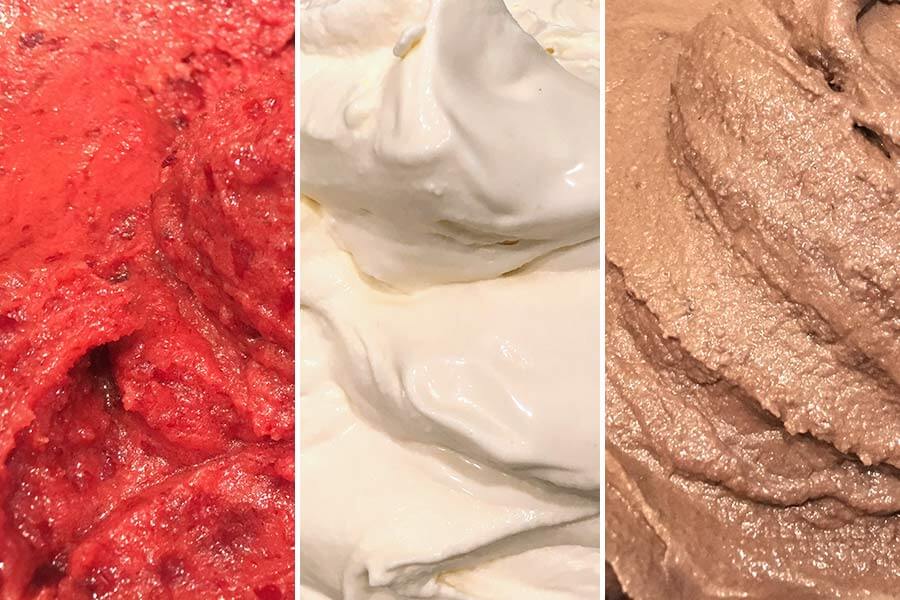
Our chef-consultants revealed that most ice-cream parlors — even ice-cream artisans — and restaurants use a pre-mixed ice cream base manufactured by a dairy distributor, such as Nestle or Hood, which the ice-cream shop flavors and customizes.
These commercial bases combine, water, fat, sugar, milk solids, and emulsifiers. They are then homogenized and pasteurized to prevent food-borne illness, as required by the U.S. Food and Drug Administration for the legal sale of commercially produced ice cream. Although a few countries in the EU continually fight restrictions on raw-milk cheeses, which can be substantially more flavorful that pasteurized cheese, we could not determine whether there is an EU manufacturer that makes ice cream with raw milk or cream.
We questioned several ice-cream companies (The Penny Ice Creamery, Salt & Straw, and a la Minute Ice Cream) about whether organic and locally sourced ingredients really affect the taste of the ice cream they make. Each company acknowledges their symbiotic business relationship with local dairy farmers and they all fervently believe their natural ingredients make better-tasting ice cream.
The experts agree that home ice-cream machines aren’t powerful enough to give professional results. They do offer tips, however, for making ice cream that closely approximates what you might purchase.
- Sugar doesn’t freeze, so it keeps ice cream soft. There is some leeway in the amounts of sugar you can use (for example, diminishing the recipe by ¼ cup), but unless you add some other ingredient that doesn’t freeze (like alcohol), it’s best to stick with the amount of sugar recommended in the recipe.
- Corn syrup adds body and suppleness to the ice cream so it won’t melt as fast. It also gives sorbets a smooth consistency.
- Fat also doesn’t freeze, but it’s not necessary to use all cream for creamy ice cream. Whole milk or half-and-half can replace cream with very good results (gelato is made almost entirely with milk).
- Corn starch will make a smooth and creamy ice cream without eggs. A small amount thickens the ice cream base into a custard-like consistency.
- Churning time affects the airiness of ice cream. A commercial machine is powerful enough to churn ice cream in 10 to 15 minutes. A home machine doesn’t have that kind of power, so it needs to churn longer, 35 to 50 minutes, to achieve a light consistency.
- Generally, all ice cream made in a home machine needs to be frozen for at least two hours after it’s been churned. This “resting period” gives the water molecules time to freeze and firm up the ice cream so it’s easier to scoop.
- Ice crystals destroy the consistency and flavor of ice cream, so freshly churned ice cream should be covered with plastic wrap and stored in a plastic rectangular container. (Deli-style containers promote the growth of ice crystals.)
Why buy an ice cream maker
At face value, an ice cream machine is a luxury item, but if you enjoy ice cream on a regular basis, it can actually be quite cost-efficient. An ice cream parlor charges around three dollars (or in the case of gelato, four dollars) for a single scoop and that’s without any add-ins. A pint of Ben and Jerry’s can set you back six or seven dollars. When you make your own ice cream, the cost for two quarts is about five dollars.
It may also be important for you to know exactly what’s going into your ice cream, especially if you prefer to eat organic or have a food allergy. With a few of the machines we tested, we were able to reproduce ice creams and sorbets that tasted like those you buy at an ice cream parlor but with less processed ingredients.
Today’s compressor ice-cream makers take ice and rock salt out of the picture altogether (except for the nostalgic, vintage-style machines), so homemade ice cream couldn’t be easier. And let’s face it, making ice cream is fun. Although we used the same recipes for all the machines during our testing, we couldn’t wait to get creative and try out flavors and add-ins after the testing was completed.
Important features to consider
Compressor style: Although compressor models are more expensive, in the long run, we found they were the best for rapidly churning quarts of excellent ice cream in a short period of time. Compressor models are self-cooling, like mini refrigerator-freezers, so you don’t need to pre-freeze the canister. Also, because the machine stays cold, you can churn out continuous quarts without waiting.
Freezer-bowl style: A less-expensive alternative is a machine with a removable freezer bowl. The bowl is filled with a liquid gel that must be frozen in your freezer for at least 12 hours before you plan on churning ice cream. Although we could only churn two quarts of ice cream per day in the freezer-bowl model, we did find that the freezer bowl did an efficient job.
Capacity: Three of the machines we tested had a 1.5-quart capacity, while two machines had a 2-quart capacity. The ice-and-salt model, Hamilton Beach – 68330N had double the capacity at four quarts. For the compressor models, we found a 1.5-quart capacity sufficient, since we could make several quarts one after another. If you want to make more than two quarts in the Cuisinart – ICE-60W, you’ll need to buy an additional freezer bowl.
Add-in spout: If you want to add in your favorite nuts and candy to your ice cream, then look for a machine with a spout. It’s a convenient and practical feature, since removing the lid entirely during the churning process will lower the temperature of the ice cream and lengthen the time it takes to freeze.
The bottom line
If you love ice cream like we do, then an ice cream machine isn’t a luxury item but a “must-have” appliance that you’ll want to use every day. The compressor-model ice cream maker takes all the fuss and mess out of ice-cream making of yore. The less-expensive machines might save you money at first, but we believe they won’t hold up as long as the compressor models, nor will they make ice cream you’ll really enjoy.
For under $300, the Whynter – ICM-200LS is our top pick. It’s easy to use, easy to clean and makes the same dense, rich and creamy ice cream and sorbet that you’d find at an ice cream parlor.
For a slightly less expensive option, we also recommend the Cuisinart – ICE-100, another compressor model, that’s very user-friendly and makes a satisfying high-end supermarket ice cream.
And if money is no object, go for the Musso – 4080 Musso Lussino, an impeccably and beautifully designed machine that churns out restaurant-quality frozen desserts in 30 minutes.
More Reviews
The Best Pillows for Side Sleepers
Coop Home Goods - Eden
RTIC - 30-Ounce Tumbler
The 8 Best Portable (Countertop) Ice Makers
Hamilton Beach - 86150
Breville - BHM800SIL
Shark Genius - S5003D
HelloFresh Meal Delivery Kit Review
HelloFresh
Nutribullet - Pro 900 Series
Thermos - Sipp
ThermoWorks - Thermapen



